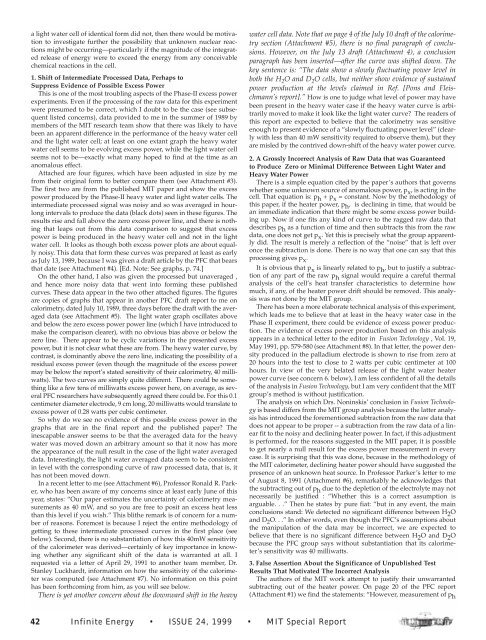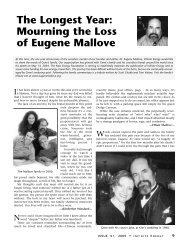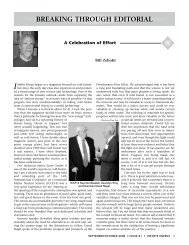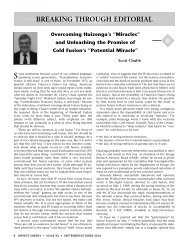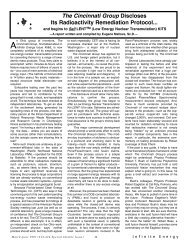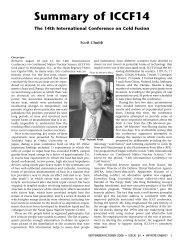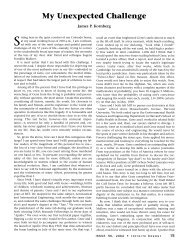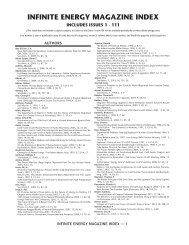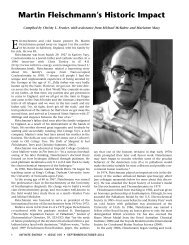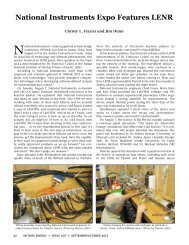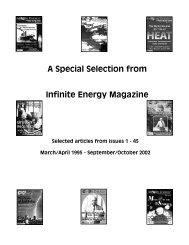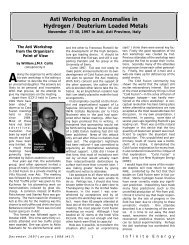MIT and Cold Fusion: A Special Report - Infinite Energy Magazine
MIT and Cold Fusion: A Special Report - Infinite Energy Magazine
MIT and Cold Fusion: A Special Report - Infinite Energy Magazine
You also want an ePaper? Increase the reach of your titles
YUMPU automatically turns print PDFs into web optimized ePapers that Google loves.
a light water cell of identical form did not, then there would be motivation<br />
to investigate further the possibility that unknown nuclear reactions<br />
might be occurring—particularly if the magnitude of the integrated<br />
release of energy were to exceed the energy from any conceivable<br />
chemical reactions in the cell.<br />
1. Shift of Intermediate Processed Data, Perhaps to<br />
Suppress Evidence of Possible Excess Power<br />
This is one of the most troubling aspects of the Phase-II excess power<br />
experiments. Even if the processing of the raw data for this experiment<br />
were presumed to be correct, which I doubt to be the case (see subsequent<br />
listed concerns), data provided to me in the summer of 1989 by<br />
members of the <strong>MIT</strong> research team show that there was likely to have<br />
been an apparent difference in the performance of the heavy water cell<br />
<strong>and</strong> the light water cell; at least on one extant graph the heavy water<br />
water cell seems to be evolving excess power, while the light water cell<br />
seems not to be—exactly what many hoped to find at the time as an<br />
anomalous effect.<br />
Attached are four figures, which have been adjusted in size by me<br />
from their original form to better compare them (see Attachment #3).<br />
The first two are from the published <strong>MIT</strong> paper <strong>and</strong> show the excess<br />
power produced by the Phase-II heavy water <strong>and</strong> light water cells. The<br />
intermediate processed signal was noisy <strong>and</strong> so was averaged in hourlong<br />
intervals to produce the data (black dots) seen in these figures. The<br />
results rise <strong>and</strong> fall above the zero excess power line, <strong>and</strong> there is nothing<br />
that leaps out from this data comparison to suggest that excess<br />
power is being produced in the heavy water cell <strong>and</strong> not in the light<br />
water cell. It looks as though both excess power plots are about equally<br />
noisy. This data that form these curves was prepared at least as early<br />
as July 13, 1989, because I was given a draft article by the PFC that bears<br />
that date (see Attachment #4). [Ed. Note: See graphs, p. 74.]<br />
On the other h<strong>and</strong>, I also was given the processed but unaveraged ,<br />
<strong>and</strong> hence more noisy data that went into forming these published<br />
curves. These data appear in the two other attached figures. The figures<br />
are copies of graphs that appear in another PFC draft report to me on<br />
calorimetry, dated July 10, 1989, three days before the draft with the averaged<br />
data (see Attachment #5). The light water graph oscillates above<br />
<strong>and</strong> below the zero excess power power line (which I have introduced to<br />
make the comparison clearer), with no obvious bias above or below the<br />
zero line. There appear to be cyclic variations in the presented excess<br />
power, but it is not clear what these are from. The heavy water curve, by<br />
contrast, is dominantly above the zero line, indicating the possibility of a<br />
residual excess power (even though the magnitude of the excess power<br />
may be below the report’s stated sensitivity of their calorimetry, 40 milliwatts).<br />
The two curves are simply quite different. There could be something<br />
like a few tens of milliwatts excess power here, on average, as several<br />
PFC researchers have subsequently agreed there could be. For this 0.1<br />
centimeter diameter electrode, 9 cm long, 20 milliwatts would translate to<br />
excess power of 0.28 watts per cubic centimeter.<br />
So why do we see no evidence of this possible excess power in the<br />
graphs that are in the final report <strong>and</strong> the published paper? The<br />
inescapable answer seems to be that the averaged data for the heavy<br />
water was moved down an arbitrary amount so that it now has more<br />
the appearance of the null result in the case of the light water averaged<br />
data. Interestingly, the light water averaged data seem to be consistent<br />
in level with the corresponding curve of raw processed data, that is, it<br />
has not been moved down.<br />
In a recent letter to me (see Attachment #6), Professor Ronald R. Parker,<br />
who has been aware of my concerns since at least early June of this<br />
year, states: “Our paper estimates the uncertainty of calorimetry measurements<br />
as 40 mW, <strong>and</strong> so you are free to posit an excess heat less<br />
than this level if you wish.” This blithe remark is of concern for a number<br />
of reasons. Foremost is because I reject the entire methodology of<br />
getting to these intermediate processed curves in the first place (see<br />
below). Second, there is no substantiation of how this 40mW sensitivity<br />
of the calorimeter was derived—certainly of key importance in knowing<br />
whether any significant shift of the data is warranted at all. I<br />
requested via a letter of April 29, 1991 to another team member, Dr.<br />
Stanley Luckhardt, information on how the sensitivity of the calorimeter<br />
was computed (see Attachment #7). No information on this point<br />
has been forthcoming from him, as you will see below.<br />
There is yet another concern about the downward shift in the heavy<br />
water cell data. Note that on page 4 of the July 10 draft of the calorimetry<br />
section (Attachment #5), there is no final paragraph of conclusions.<br />
However, on the July 13 draft (Attachment 4), a conclusion<br />
paragraph has been inserted—after the curve was shifted down. The<br />
key sentence is: “The data show a slowly fluctuating power level in<br />
both the H 2 O <strong>and</strong> D 2 O cells, but neither show evidence of sustained<br />
power production at the levels claimed in Ref. [Pons <strong>and</strong> Fleischmann’s<br />
report].” How is one to judge what level of power may have<br />
been present in the heavy water case if the heavy water curve is arbitrarily<br />
moved to make it look like the light water curve? The readers of<br />
this report are expected to believe that the calorimetry was sensitive<br />
enough to present evidence of a “slowly fluctuating power level” (clearly<br />
with less than 40 mW sensitivity required to observe them), but they<br />
are misled by the contrived down-shift of the heavy water power curve.<br />
2. A Grossly Incorrect Analysis of Raw Data that was Guaranteed<br />
to Produce Zero or Minimal Difference Between Light Water <strong>and</strong><br />
Heavy Water Power<br />
There is a simple equation cited by the paper’s authors that governs<br />
whether some unknown source of anomalous power, p x , is acting in the<br />
cell. That equation is: p h + p x = constant. Now by the methodology of<br />
this paper, if the heater power, p h , is declining in time, that would be<br />
an immediate indication that there might be some excess power building<br />
up. Now if one fits any kind of curve to the ragged raw data that<br />
describes p h as a function of time <strong>and</strong> then subtracts this from the raw<br />
data, one does not get p x . Yet this is precisely what the group apparently<br />
did. The result is merely a reflection of the “noise” that is left over<br />
once the subtraction is done. There is no way that one can say that this<br />
processing gives p x .<br />
It is obvious that p x is linearly related to p h , but to justify a subtraction<br />
of any part of the raw p h signal would require a careful thermal<br />
analysis of the cell’s heat transfer characteristics to determine how<br />
much, if any, of the heater power drift should be removed. This analysis<br />
was not done by the <strong>MIT</strong> group.<br />
There has been a more elaborate technical analysis of this experiment,<br />
which leads me to believe that at least in the heavy water case in the<br />
Phase II experiment, there could be evidence of excess power production.<br />
The evidence of excess power production based on this analysis<br />
appears in a technical letter to the editor in <strong>Fusion</strong> Technology , Vol. 19,<br />
May 1991, pp. 579-580 (see Attachment #8). In that letter, the power density<br />
produced in the palladium electrode is shown to rise from zero at<br />
20 hours into the test to close to 2 watts per cubic centimeter at 100<br />
hours. In view of the very belated release of the light water heater<br />
power curve (see concern 6. below), I am less confident of all the details<br />
of the analysis in <strong>Fusion</strong> Technology, but I am very confident that the <strong>MIT</strong><br />
group’s method is without justification.<br />
The analysis on which Drs. Noninskis’ conclusion in <strong>Fusion</strong> Technology<br />
is based differs from the <strong>MIT</strong> group analysis because the latter analysis<br />
has introduced the forementioned subtraction from the raw data that<br />
does not appear to be proper -- a subtraction from the raw data of a linear<br />
fit to the noisy <strong>and</strong> declining heater power. In fact, if this adjustment<br />
is performed, for the reasons suggested in the <strong>MIT</strong> paper, it is possible<br />
to get nearly a null result for the excess power measurement in every<br />
case. It is surprising that this was done, because in the methodology of<br />
the <strong>MIT</strong> calorimeter, declining heater power should have suggested the<br />
presence of an unknown heat source. In Professor Parker’s letter to me<br />
of August 8, 1991 (Attachment #6), remarkably he acknowledges that<br />
the subtracting out of p h due to the depletion of the electrolyte may not<br />
necessarily be justified : “Whether this is a correct assumption is<br />
arguable. . .” Then he states by pure fiat: “but in any event, the main<br />
conclusions st<strong>and</strong>: We detected no significant difference between H 2 O<br />
<strong>and</strong> D 2 O. . .” In other words, even though the PFC’s assumptions about<br />
the manipulation of the data may be incorrect, we are expected to<br />
believe that there is no significant difference between H 2 O <strong>and</strong> D 2 O<br />
because the PFC group says without substantiation that its calorimeter’s<br />
sensitivity was 40 milliwatts.<br />
3. False Assertion About the Significance of Unpublished Test<br />
Results That Motivated The Incorrect Analysis<br />
The authors of the <strong>MIT</strong> work attempt to justify their unwarranted<br />
subtracting out of the heater power. On page 20 of the PFC report<br />
(Attachment #1) we find the statements: “However, measurement of p h<br />
42 <strong>Infinite</strong> <strong>Energy</strong> • ISSUE 24, 1999 • <strong>MIT</strong> <strong>Special</strong> <strong>Report</strong>


